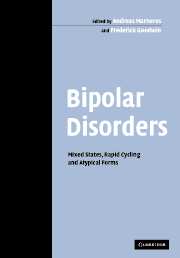Book contents
- Frontmatter
- Contents
- List of contributors
- Preface
- 1 Bipolar disorders beyond major depression and euphoric mania
- 2 Emerging concepts of mixed states: a longitudinal perspective
- 3 Rapid-cycling bipolar disorder
- 4 Bipolar I and bipolar II: a dichotomy?
- 5 Recurrent brief depression as an indicator of severe mood disorders
- 6 Atypical depression and its relation to bipolar spectrum
- 7 Agitated depression: spontaneous and induced
- 8 Schizoaffective mixed states
- 9 Acute and transient psychotic disorder: an atypical bipolar disorder?
- 10 Bipolar disorder in children and adolescents
- 11 Atypical features of bipolarity in old age
- 12 Comorbidity in mixed states and rapid-cycling forms of bipolar disorders
- 13 Challenges in the genetics of bipolar disorder
- 14 Biological aspects of rapid-cycling and mixed states
- 15 The treatment of bipolar mixed states
- 16 The use of atypical antipsychotic agents in the treatment of diagnostic subgroups of bipolar disorder: mixed and pure states, psychotic and non-psychotic
- 17 Investigational strategies: treatment of rapid cycling, mixed episodes, and atypical bipolar mood disorder
- Index
- References
7 - Agitated depression: spontaneous and induced
Published online by Cambridge University Press: 10 August 2009
- Frontmatter
- Contents
- List of contributors
- Preface
- 1 Bipolar disorders beyond major depression and euphoric mania
- 2 Emerging concepts of mixed states: a longitudinal perspective
- 3 Rapid-cycling bipolar disorder
- 4 Bipolar I and bipolar II: a dichotomy?
- 5 Recurrent brief depression as an indicator of severe mood disorders
- 6 Atypical depression and its relation to bipolar spectrum
- 7 Agitated depression: spontaneous and induced
- 8 Schizoaffective mixed states
- 9 Acute and transient psychotic disorder: an atypical bipolar disorder?
- 10 Bipolar disorder in children and adolescents
- 11 Atypical features of bipolarity in old age
- 12 Comorbidity in mixed states and rapid-cycling forms of bipolar disorders
- 13 Challenges in the genetics of bipolar disorder
- 14 Biological aspects of rapid-cycling and mixed states
- 15 The treatment of bipolar mixed states
- 16 The use of atypical antipsychotic agents in the treatment of diagnostic subgroups of bipolar disorder: mixed and pure states, psychotic and non-psychotic
- 17 Investigational strategies: treatment of rapid cycling, mixed episodes, and atypical bipolar mood disorder
- Index
- References
Summary
Sometimes it is more “inward anxiety and trembling,” a painful tension; sometimes it is an anxious restlessness, which finds an outlet in the most varied gestures, in states of violent excitement, and in heedless attempts at suicide. These moods are most frequently found in the periods of transition between states of depression and mania; they are, therefore, probably most correctly regarded as mixed states of depression and manic excitability (Kraepelin, 1913).
The inner unrest is the constant thing, while the motor unrest is variable (Lewis, 1934).
Introduction
The greatest shortcoming of psychiatry is the near complete lack of knowledge of the pathophysiological processes underlying our clinical entities. Kahlbaum (1863) was the first to distinguish clearly between symptomatic clinical pictures and the disease process that was responsible for them. Kraepelin took this concept a step further and based the idea of the disease process (Vorgang) on the conditions under which the disease starts, its course, and outcome. This method of clinical psychiatry achieved the separation of manic-depressive illness from dementia praecox. But the real identity of the pathophysiological process underlying the clinical entities still remains obscure. Our psychiatric nosology is entirely based on phenomenology and course.
We do, however, have important tools at our disposal, which are the psychoactive drugs. The response to these drugs not only indicates the pharmacological action of the drug itself but also provides important clues about the nature of the neuropathologic process upon which the drug acts.
Keywords
- Type
- Chapter
- Information
- Bipolar DisordersMixed States, Rapid Cycling and Atypical Forms, pp. 157 - 186Publisher: Cambridge University PressPrint publication year: 2005
References
- 1
- Cited by



